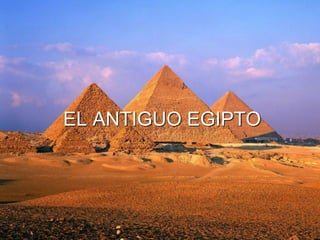
La importancia del río Nilo para el antiguo Egipto
- 2. 1. EL PAÍS DEL NILO EGIPTO DEBE SU EXISTENCIA AL NILO EGIPTO SÓLO ES HABITABLE EN 12 KM A CADA LADO DEL NILO LAS INUNDACIONES DEL NILO DABAN FERTILIDAD A LA TIERRA LOS EGIPCIOS APRENDIERON A CONTROLAR LAS CRECIDAS DEL NILO
- 3. IMPORTANCIA DEL RÍO NILO En Egipto, la lluvia era un fenómeno extraordinario y excepcional. Cada año, durante la época de las lluvias, se producía la crecida del Nilo, y con esta inundación anual las tierras se llenaban de limo que era lo que hacía fertilizar la tierra. Sin el Nilo, Egipto habría sido seguramente un desierto. La observación sistemática, tanto de las inundaciones del Nilo como de las estrellas del cielo, condujo a los egipcios a la creación de un calendario de trescientos sesenta y cinco días, dividido en tres estaciones o períodos: crecida, siembra y cosecha.
- 5. 2. LA TIERRA DEL FARAÓN EGIPTO SURGIÓ ALREDEDOR DEL 3100 A. C. CUANDO EL REY MENES UNIFICÓ EL ALTO Y BAJO EGIPTO EL IMPERIO EGIPCIO DESAPARECIÓ EL 31 A. C. (3000 AÑOS DE DURACIÓN) EL REY, QUE ERA TAMBIÉN UN DIOS, TENÍA TODO EL PODER (FARAÓN)
- 6. LAS DINASTÍAS CUANDO UN FARAÓN MORÍA, LO SUCEDÍA SU HIJO UNA FAMILIA DE FARAONES FORMABA UNA DINASTÍA (31) EN EGIPTO HUBO 3 PERIODOS: EL IMPERIO ANTIGUO, EL IMPERIO MEDIO Y EL IMPERIO NUEVO
- 8. EL IMPERIO ANTIGUO COMENZÓ EN EL 3.1OO A.C. SU CAPITAL ERA MENFIS LOS EMPERADORES MÁS IMPORTANTES FUERON KEOPS, KEFRÉN Y MICERINOS SE CONSTRUYERON LAS PIRÁMIDES
- 9. EL IMPERIO MEDIO SU CAPITAL FUE TEBAS SE EXPANDIÓ HACIA EL SUR (NUBIA) TERMINÓ CUANDO FUE INVADIDO POR EXTRANJEROS
- 10. EL IMPERIO NUEVO COMENZÓ EN EL 1.600 A.C. FUE EL PERIODO DE MÁXIMO ESPLENDOR SE EXPANDIÓ POR LIBIA Y SIRIA
- 11. RAMSES II FUE EL FARAÓN MÁS IMPORTANTE DEL IMPERIO NUEVO CONSTRUYÓ MUCHOS TEMPLOS ERA TIRÁNICO Y CRUEL (HACÍA SACRIFICOS HUMANOS) TUVO DECENAS DE ESPOSAS Y 152 HIJOS FUE DERROTADO POR LOS HITITAS EN KADESH
- 12. 3. LA SOCIEDAD EGIPCIA ESTABA DIVIDIDA EN: FARAÓN Y SU FAMILIA PRIVILEGIADOS: NOBLES, SACERDOTES Y ESCRIBAS NO-PRIVILEGIADOS: CAMPESINOS, ARTESANOS, COMERCIANTES, ESCLAVOS
- 13. LA VIDA COTIDIANA LOS EGIPCIOS VIVÍAN EN CASAS DE ADOBE HABÍA GRANDES CIUDADES (TEBAS, MENFIS) HABÍA MUCHO COMERCIO, PERO SIN MONEDA EN VERANO, LOS EGIPCIOS AYUDABAN AL FARAÓN A CONSTRUIR GRANDES OBRAS COMÍAN MUCHA FRUTA Y HORTALIZAS BEBÍAN CERVEZA
- 15. 4. LA RELIGIÓN LOS EGIPCIOS ERAN POLITEÍSTAS SU DIOS PRINCIPAL ERA EL SOL, QUE FUE CAMBIANDO DE NOMBRE (RA – AMÓN – ATÓN) OTROS DIOSES FUERON ISIS, OSIRIS Y HORUS LOS EGIPCIOS PENSABAN QUE LAS CRECIDAS DEL NILO DEPENDÍAN DEL FARAÓN Y LOS DIOSES
- 16. OSIRIS; EL SOL PONIENTE Osiris, “El sol poniente”, dios fecundador y supremo juez que otorga la inmortalidad a los hombres. Representación: Humano momificado con la corona blanca y 2 plumas.
- 17. HORUS; EL SOL NACIENTE Horus, “El sol naciente”. Estaba encarnado en el faraón. Representación: Hombre con cabeza de halcón, o halcón
- 18. AMÓN; DIOS DE LA CIUDAD DE TEBAS Amón, dios de la ciudad de Tebas. Representación: Humano coronado con 2 largas plumas verticales.
- 19. LA RELIGIÓN EGIPCIA LA RELIGIÓN EGIPCIA INTENTABA EXPLICAR LA CREACIÓN DEL MUNDO LA OTRA VIDA SE ALCANZABA TRAS SUPERAR EL JUICIO DE OSIRIS
- 21. 5. LA VIDA DESPUÉS DE LA MUERTE. LAS TUMBAS. LOS EGIPCIOS CREÍAN QUE, SI EL CADÁVER ERA CONSERVADO Y RECIBÍA RITOS ESPECIALES, HABÍA UNA VIDA DESPUÉS DE LA MUERTE EL CUERPO ERA MOMIFICADO Y ENTERRADO CON UN AJUAR LA TUMBA TENÍA UNA ESTATUA DEL MUERTO (KA) A LA QUE HABÍA QUE LLEVAR ALIMENTOS
- 23. MOMIA DE RAMSÉS II
- 24. AKENATÓN, “EL FARAÓN HEREJE” AKENATÓN CAMBIÓ LA RELIGIÓN EGIPCIA PROCLAMÓ QUE SÓLO HABÍA UN DIOS (ATÓN) TRASLADÓ LA CAPITAL A AMARNA SU ESPOSA NEFERTITI COLABORÓ CON ÉL EN EL PODER LOS SACERDOTES DE AMÓN RECHAZARON EL MONOTEISMO
- 25. TEMPLO DE LUXOR
- 26. TEMPLO DE LUXOR
- 27. TEMPLO DE LUXOR
- 28. TIPOS DE TUMBAS LAS MASTABAS FORMA DE PIRÁMIDE TRUNCADA. LAS MÁS ANTIGUAS ENTERRADAS BAJO ELLAS HABÍA UNA CÁMARA FUNERARIA
- 29. TIPOS DE TUMBAS LAS PIRÁMIDES RESERVADA A LOS FARAONES GALERÍAS PROTEGIDAS POR TRAMPAS LA CÁMARA FUNERARIA ESTABA EN EL CENTRO O BAJO ELLA EJEM: KEOPS, KEFRÉN Y MICERINOS
- 30. ESQUEMA DE LAS PIRÁMIDES
- 31. LA ESFINGE DE GIZEH
- 32. ABU SIMBEL
- 33. EL ARTE EGIPCIO ERA UN ARTE RELIGIOSO FUNERARIO CAMBIÓ MUY POCO EN 4.000 AÑOS RASGOS DE LA PINTURA: FALTA DE PERSPECTIVA FRONTALIDAD IDEALIZACIÓN INMOVILIDAD
- 35. EL BUSTO DE NEFERTITI